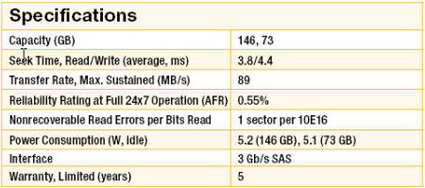Intel’s 24-Core, 14-Drive Modular Server Reviewed
Disk Drives
The MFSYS25 chassis comes with a built-in SAN that can hold up to 14 hot-swappable SAS drives. Intel sent us enough drives to fully populate the chassis’ storage bay, comprising 14 Seagate Savvio 10K.2 drives. The 2.5" Savvio 10K.2 has a capacity of 73 GB and is 70% smaller than the larger 3.5" drives and uses less power than its larger siblings. Its compact size also adds more flexibility for configuring different RAID levels 0 to 60.
All together, 952 GB of space are available for configuring virtual drives for the compute modules used in the chassis. Looking to the future, Intel can be expected to replace these drives with larger capacity products, therefore increasing overall storage significantly.
Get Tom's Hardware's best news and in-depth reviews, straight to your inbox.
-
kevikom This is not a new concept. HP & IBM already have Blade servers. HP has one that is 6U and is modular. You can put up to 64 cores in it. Maybe Tom's could compare all of the blade chassis.Reply -
sepuko Are the blades in IBM's and HP's solutions having to carry hard drives to operate? Or are you talking of certain model or what are you talking about anyway I'm lost in your general comparison. "They are not new cause those guys have had something similar/the concept is old."Reply -
Why isn't the poor network performance addressed as a con? No GigE interface should be producing results at FastE levels, ever.Reply
-
nukemaster So, When you gonna start folding on it :pReply
Did you contact Intel about that network thing. There network cards are normally top end. That has to be a bug.
You should have tried to render 3d images on it. It should be able to flex some muscles there. -
MonsterCookie Now frankly, this is NOT a computational server, and i would bet 30% of the price of this thing, that the product will be way overpriced and one could buid the same thing from normal 1U servers, like Supermicro 1U Twin.Reply
The nodes themselves are fine, because the CPU-s are fast. The problem is the build in Gigabit LAN, which is jut too slow (neither the troughput nor the latency of the GLan was not ment for these pourposes).
In a real cumputational server the CPU-s should be directly interconnected with something like Hyper-Transport, or the separate nodes should communicate trough build-in Infiniband cards. The MINIMUM nowadays for a computational cluster would be 10G LAN buid in, and some software tool which can reduce the TCP/IP overhead and decrease the latency. -
less its a typo the bench marked older AMD opterons. the AMD opteron 200s are based off the 939 socket(i think) which is ddr1 ecc. so no way would it stack up to the intel.Reply
-
The server could be used as a Oracle RAC cluster. But as noted you really want better interconnects than 1gb Ethernet. And I suspect from the setup it makes a fare VM engine.Reply


